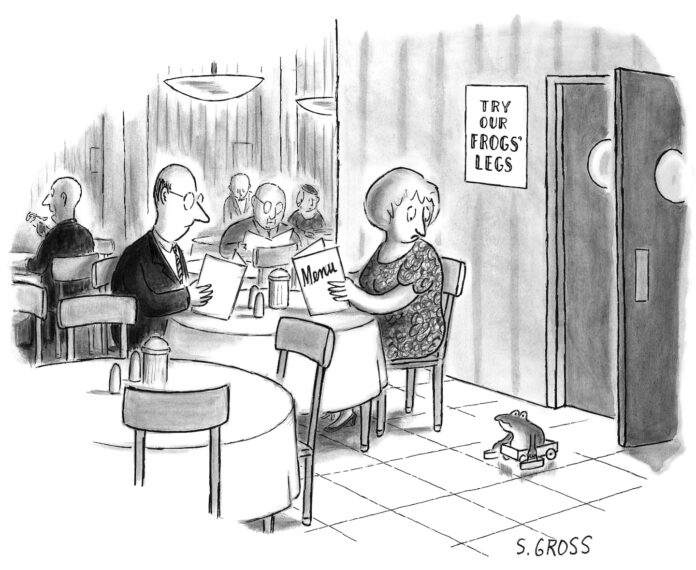A cantankerous f-bomb slinger, Mr. Gross refused to kowtow to societal boundaries of humor. One of his best-remembered cartoons, published in 1970 in the National Lampoon, depicts a couple at a fancy restaurant. A sign on the wall says, “Try our frogs’ legs.” On the floor, a legless frog rolls in from the kitchen in a wheelchair.
“Sam used taboo as fuel, but behind the shock there was a hard reality,” wrote Michael Gerber, publisher of the humor magazine American Bystander, where Mr. Gross sometimes published his work. “Your fancy dinner is someone else’s legs. Sam’s genius was a kind of radical honesty, which led him to places others would not go.”
Mr. Gross was in some ways two cartoonists, both absurdly funny.
In the National Lampoon, where Mr. Gross published more than 400 cartoons and served as cartoon editor, no subject was off-limits — race, sex, the disabled, everything. One of his 10 books is a collection of cartoons featuring swastikas titled “We Have Ways of Making You Laugh: 120 Funny Swastika Cartoons.” (Mr. Gross was Jewish.)
But in mainstream publications, especially the New Yorker, a magazine that for decades would not print four-letter words, his panels were notably less edgy.
Of the hundreds of cartoons Mr. Gross published there, the most famous is of two snails chatting near a tape dispenser. “I don’t care if she is a tape dispenser,” one says. “I love her.”
Robert Mankoff, the New Yorker’s cartoon editor from 1997 to 2017, said Mr. Gross published “some of the funniest cartoons ever,” and in the great pantheon of New Yorker cartoonists — Charles Addams, Saul Steinberg, George Booth, among others — “there was no one funnier than Sam.”
Before embarking on a career in cartooning, Mr. Gross worked briefly as an accountant, and he brought the fastidiousness of that profession to a tiny apartment near his home that he converted into a studio. On each back, he numbered every cartoon he drew, filing them in cabinets that overtook the kitchen and in books that filled the bathtub. His final total was nearly 34,000.
Mr. Gross thought of himself as a joke writer more than an artist.
“I don’t consider myself a great artist or even that much of a good artist. What I consider myself is a really good gag man,” he said in an interview with the blog a Case for Pencils. “I can’t draw a horse to save myself, but a lot of other people can’t. I’m in good company with horses or lack of ability to draw horses, but I can tell a joke and it takes a lot of work to do.”
Samuel Harry Gross was born in the Bronx on Aug. 7, 1933. His father was an accountant, and his mother was a homemaker.
Asked by the Comics Journal when he became a full-time cartoonist, Mr. Gross said: “I drew on the desk with crayon and ink in first grade. My teacher, Mrs. Levy, sent me home with a note. My mother had to come to school with Kirkman soap and we had to scour the desk.”
He got his sense of humor from his mother.
“She was funny but insulting,” he told the Virtual Memories Show, a podcast. “She was just outrageous at times.”
Mr. Gross studied business, accounting and advertising at City College. While a student, he sold his first cartoon to the Saturday Review. It depicted a scholarly looking man being interrogated by police officers. The man says, “It all began when my Phi Beta Kappa key fit into the bank vault.”
After graduating in 1954, he was drafted into the Army and served two years in Germany. There, his cartoons ran in an Army newspaper. A publisher in Frankfurt liked them and collected them in Mr. Gross’s first book, “Cartoons for the GI.” Following his discharge, he worked briefly as an accountant.
By the early 1960s, Mr. Gross set out to become a full-time cartoonist. In addition to the New Yorker and National Lampoon, he published drawings in Esquire, Cosmopolitan, Good Housekeeping, the Harvard Business Review and other outlets. His books include “I Am Blind and My Dog Is Dead,” “More Gross,” “Totally Gross,” and “Your Mother Is a Remarkable Woman.”
Survivors include his wife, the former Isabelle Jaffe, whom he married in 1959; a daughter; and a sister.
Mr. Gross was also a gentle and encouraging mentor to scores of cartoonists. On one matter he was especially firm: getting paid. He was fiercely opposed to cartoonists publishing work simply for “exposure,” a word and idea he found despicable. He followed this rule until his death.
Mankoff said a publisher was recently putting together a book of photography featuring legendary New Yorker cartoonists and their work. There was not enough money in the budget to cover payments for drawings.
“Now most cartoonists would want to be in the book anyway,” Mankoff said. “Sam didn’t give a s—. So he’s not in the book.”



